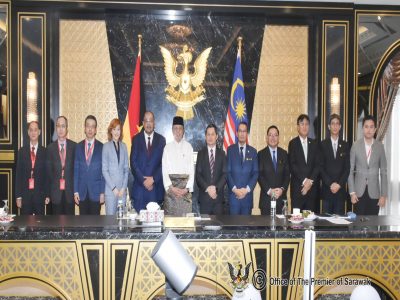Five years on from deadly cyclone that claimed more than 6,000 lives, children reveal the trauma of surviving Typhoon Haiyan
Five years ago on 8 November, Typhoon Haiyan – one of the destructive tropical cyclones ever recorded – hit Southeast Asia, killing more than 6,000 people and leaving an estimated $2.8 billion worth of damage.
Eleven-year-old Marylourds Lim still bears the scars Haiyan left.
“I got so many wounds and my foot was pierced by a nail, a lot of blood was coming out,” she said.
Marylourds was six when the typhoon hit. Along with her sister and grandfather, she climbed a mountain to seek sanctuary from the floods.
She said, “I was so afraid, I asked if I was going to die. The rain was so strong and I was almost hit by lightning.”
Eventually, Marylourds’s physical injuries healed, but the mental trauma she suffered took years to come to terms with and every time rain fell, her anxieties resurfaced.
“I kept thinking about it. I kept dreaming a dog was chasing me. I felt that there was another typhoon coming,” Marylourds said.
Julianna Cabibihan, 11, has also struggled to deal with what happened.
“I heard the sounds of the wind and people shouting for help. The wind was so strong and the rain was so painful when it hit my skin,” she said.
During the floods, ten feet of water entered Juliana’s house and the wind blew the building’s roof off. The family spent three hours clinging to what was left of the roof, waiting for the waters to subside.
Unable to swim, Julianna was terrified she might end up washed away.
Julianna said, “We thought we were going to die.”
Marylourds and Julianna attend a Seafarers’ Pupils’ Club at Dr AP Banez Memorial Elementary School in Tacloban, set up by international maritime charity Sailors’ Society to provide support for children affected by the disaster.
The charity’s deputy CEO and director of programme Sandra Welch said, “After the disaster I visited the Philippines and spent a lot of time speaking to the children in the schools. I realised as I spoke to them that many of them were traumatised by what had happened and that they were still afraid.”
The club is run by the charity’s family outreach officer, Iris Picardal.
Like the girls, Iris survived Haiyan’s destruction.
“I didn’t have any injuries and our house wasn’t destroyed, but I had trauma,” she said.
As the winds ceased, the true toll of the typhoon became obvious.
Iris said, “People were telling us there were many bodies in the streets. I knew that I couldn’t bear to see the lost, but you could smell the dead bodies.”
Living in a disaster prone area, Iris knows the chances of another typhoon striking are high.
“The best thing we can do is to be ready when the next disaster comes,” she said.
Sailors’ Society has developed a programme to help rebuild the children’s confidence and give them disaster risk reduction training.
Sandra said, “The main role of the club is to teach the children about disaster resilience, and give them confidence to work through the trauma that they’ve experienced.”
Marylourds said, “We were taught how to prepare before and after the typhoon, what we should do. I’m not afraid anymore.”
Annielor Malooy has been teaching at Dr AP Banez Memorial Elementary School for more than 25 years. Haiyan was the worst typhoon she’s experienced in her 60 years.
She lost all her possessions in the devastation and had to borrow food from neighbours to survive.
Alongside getting her family’s life back on track, she was faced with the dilemma of how best to support her pupils.
“At first there were very few children. They weren’t interested in lessons, we just spoke about what happened,” she said.
Many of her pupils had lost members loved ones, while others transferred to different schools.
“Some of my pupils died,” she said.
The pupils were deeply traumatised by the events.
“They would just stare blankly at me, even when I encouraged them to take part, they couldn’t.
“I just left them until they asked for me.”
When the children did turn to Annielor, the stories she heard were harrowing.
“They were telling me ‘my mother died’, ‘my father died’, ‘we don’t have any food’ – I gave them my love but that’s not enough when someone has lost everything.
“I had to be strong, for my pupils.”
The school focused on the children’s emotional well-being rather than academic lessons.
They played games, told stories, drew and sang.
Gradually, the pupils began to come to terms with their ordeal.
Annielor said, “Sailors’ Society came in at a time when our school really needed their support.
“They would take the children swimming or to the park, activities that would help them forget about the experiences they suffered, if only for a few hours. Little-by-little, it really helped the children.”
“As a mother, as a wife, I have realised many things. Life is more important than anything else. We can buy material things, you can’t buy back a life.”
Sandra said, “Rebuilding physical structures like houses, medical centres and schools takes a certain amount of time, but rebuilding lives – especially those of children so badly traumatised like Julianna and Marylourds – can take far longer and we’ve got to help these children and families rebuild their lives.
“Five years down the line, we’re still helping people dealing with the trauma of a disaster. Sailors’ Society does not forget those affected, we’re about transforming lives and staying with them when it’s really tough.
“We will continue to work with those communities and support them because typhoons aren’t going to go away.”
Notes to Editors:
B-roll and films of the interviews with those quoted above are available upon request.
Sandra Welch is available for interview.
Sailors’ Society responded to the disaster by raising £225,000 through an emergency appeal and has been helping communities in the Philippines rebuild ever since.
The charity has rebuilt 48 homes, four medical centres and three classrooms – that double as emergency shelters – since Typhoon Haiyan.
“Around a quarter of the world’s seafarers come from the Philippines and the country is key to world trade. It was important that when disaster struck, Sailors’ Society was able to support communities to rebuild their lives,” Stuart Rivers said.
In the immediate aftermath of the typhoon, the charity sent trained chaplains to offer practical and emotional support. It has also set up a Crisis Response Network to help those affected by trauma.
“With more than 20 deadly storms hitting the Philippines annually, our Crisis Response Network provides much-needed trauma care and counselling services to help those devastated by natural disasters pull their lives together again,” Stuart added.
Julianna Cabibihan and Marylourds Lim attend the Seafarers’ Pupil’s Club run by maritime charity Sailors’ Society
About Sailors’ Society
Sailors’ Society has been bringing people together for 200 years, transforming the lives of seafarers and their families at home, in port and at sea through the delivery of chaplaincy, education and the relief of poverty and distress.
The charity works internationally to provide practical, emotional and spiritual welfare support to the world’s 1.6m seafarers, regardless of background or faith. Sailors’ Society chaplains and ship visitors have a presence in 91 global ports, with wider projects and services covering 30 countries.
You can explore the charity’s 200 year journey at https://www.sailors-society.org/200-years/
For more information on the charity’s work and the 200th anniversary celebrations, please visit www.sailors-society.org or contact Charis Gibson or James Leslie on 023 8051 5950 or press@sailors-society.org.
Services
Stakeholder mapping, analysis, engagement and communication needs to be detailed to avoid business losses or even worse, a crisis. How can you do this effectively to prevent failure? ...
Data-driven business decisions have never been as crucial, especially in this era. MGBF leverages off, technology, experience and market presence to aid businesses in making accurate decisions. ...
MGBF provides comprehensive strategic advice and results-focused solutions to solve clients' problems in business-government relations so they can focus on their core business. ...
A critical business challenge is meeting the right decision-makers and potential buyers through the best channel and platform. How will you improve your business competency? ...
Upcoming Events
MGBF founding chairman Nordin Abdullah and UMW Toyota president Datuk Ravindran K. will delve into the convergence of automotive innovation and environmental sustainability in Penang, Sarawak, Johor and Pahang.
Hosted by menumiz™ – an end-to-end restaurant management system – this roundtable will feature a case study presentation and a panel session to discuss the latest digital trends, challenges, and opportunities within the food and beverage sector.
In this episode of 'A Working Lunch with Nordin', MGBF's founding chairman, Nordin Abdullah, will host this discussion focusing on the biggest threats and opportunities for businesses as we look to manage change in the South China Sea.
This MGBF Roundtable will focus on regional food security issues and trends in the regional supply chain, and trade regulations and policies, including a new geopolitical tool i.e., weaponisation of supply chains.
MGBF In The News

Planet QEOS, KIS BlOCNG San Bhd, and the Sarawak Land Consolidation and Rehabilitation Authority (SALCRA) have officially signed a tripartite memorandum of understanding (MoU) to establish a collaborative framework aimed at producing bio-hydrogen via the Steam Biomethane Reforming (SBMR) Process. The MoU was signed by Planet QEOS executive chairman Dino […]

Planet QEOS and China Machinery Engineering Corporation (CMEC) are interested in investing RM10 billion to co-develop advanced Megawatt peak (MWp) agrovoltaic in Baram, to further boost Sarawak’s green energy initiative and food security. Sarawak Premier Datuk Patinggi Tan Sri Abang Johari Tun Openg was briefed on Friday by both the […]

Last week SPM results came out, 373,974 aspirants who have been waiting patiently over the last few months would now know their fate. Some 10,109 have received all A’s, the golden standard of academic success and the ticket to those looking to study the “more advanced” subjects in university. Proudly, […]

The classic knee-jerk reaction is to say, fire the coach, change the leadership of associations, and reduce the funding till they start performing better. This kind of negative reinforcement may work for kindergarten children, but we are dealing with high-performance adults – individuals much further along in their psychological and […]

Since its earliest tea plantations in 1929, Cameron Highlands has grown to become a key player in the agricultural landscape of Malaysia, producing 40 per cent of all vegetables grown. Despite Malaysia shifting its economic focus away from agriculture, the industry remains imperative for food security and the livelihoods of […]

Although at first glance the travel industry and the agricultural sector appear to have nothing in common, they actually share more than meets the eye. The economic benefits of tourism to the agricultural sector can be multiplied several times over. “Tourism brings the end consumers closer to the source, which […]

The Malaysia Global Business Forum (MGBF) recently held a high-level roundtable themed ‘Designing the Future of the Digital Economy’, attended by industry leaders and business associations. The guest of honour was Yang Berhormat Syerleena Abdul Rashid, the Member of Parliament (MP) for Bukit Bendera in Penang. The MP’s Special Session […]

The Malaysia Global Business Forum (MGBF) will be hosting a roundtable on ‘Designing the Future of the Digital Economy’ on 23 February 2023. It is the culmination of the first three MGBF Exclusive Roundtable Series titled ‘The Evolving Threat Matrix in the Digital Economy’ held throughout 2022. According to the […]

The Founding Chairman of the Malaysia Global Business Forum (MGBF), Nordin Abdullah, today spoke on Bernama TV’s leading English talk show, The Brief, hosted by Jessy Chahal, on the topic of a stable political reality and what that means for the Malaysian economy. Nordin said, “The first thing that it […]

More than 1,100 years ago, Muhammad ibn Musa al-Khwarizmi was developing the mathematical formulas that we know today as algorithms which now have become so intertwined with the business fortunes of global media giants and the very fabric of geopolitics. A series of recent high level international reports have revealed […]

KSK Land has been recognised by the Malaysia Global Business Forum (MGBF) for its role in attracting high net-worth individuals to Malaysia post-pandemic. The first challenge in investor attraction is “selling” the country. In the context of Asia, Malaysia is competing with some very established investment destinations. The second […]

Malaysia, in particular Kuala Lumpur, continues to position itself as a regional centre to do business, educate a family and enjoy a global lifestyle. One company, KSK Land, has taken the lead in positioning itself and the city of Kuala Lumpur as a property investment destination for the global citizen […]

The upcoming budget represents an opportunity to build resilience in the critical sectors that will form the backbone of the country’s future-facing economic ambitions. This however needs to be achieved in the context of managing the community sectors most impacted by COVID-19 over the past two years. The Keluarga Malaysia (Malaysian Family) […]

Malaysia Global Business Forum (MGBF) has moved to support the creative economy as the overall economy moves into a recovery phase following the COVID19 pandemic. As a step in the direction of normalcy, the MGBF has agreed to host the art exhibition “I Know You’re Somewhere So Far” by one […]

Congratulations to Datuk Seri Ismail Sabri Yaakob for taking up the mantle of the ninth prime minister of Malaysia. There is nothing normal about the situation; it could not have been scripted but it has kept the spectrum of media, mainstream and social, gripped. The first order of business for […]

In a stirring speech to the nation, President Joseph R. Biden, Jr. stamped his brand of leadership on the presidency, in his first act as the 46th president of the United State of America, it signaled several shifts. Perhaps the weather was foreboding with snow falling before the ceremony that […]

KUALA LUMPUR, 6 July 2022 – As the global economy continues to deal with unprecedented levels of disruption caused by the pandemic and the conflict between Russia and Ukraine, the convergence of energy security and food security issues has become a front-of-mind issue faced by policy makers and consumers alike. […]

KUALA LUMPUR, 23 June 2022 — Malaysia Global Business Forum (MGBF) ties up with scoutAsia to ensure that businesses are equipped with deeper regional insights. The past two years has seen a massive shift in the way businesses are conducted with digitisation, digitalisation and automation continuously being adopted to improve […]

KUALA LUMPUR, 25 May 2022 – The Malaysia Global Business Forum (MGBF)’s exclusive roundtable on ‘Security Concerns in Critical Value Chains’ was held in a hybrid setting yesterday at the Eastin Hotel Kuala Lumpur. The guest of honour was Yang Berbahagia Tan Sri Dato’ Seri Rafidah Aziz, former minister of […]


































